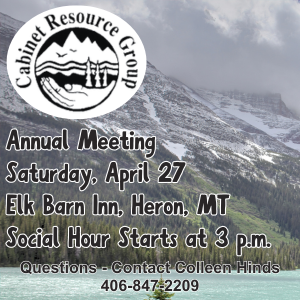Remember When?
September 16, 2021
LOOKING BACK
By Orin P. Kendall
I am sure that there is no record as to who made the first trip through Sanders County by automobile but I can imagine that the person who made it didn’t forget it for a long time.
What is now Highway 200 was at one time Montana 3 and later Alternate 10 but for many years it was just a series of roads connecting the towns. The highway roughly parallels the old Kootenai Trail used by the Salish Indians and the early trappers and traders for many years.
There is very little of old Montana 3 that is a part of 200 today. At the risk of being tiresome I will describe the road as I remember it 55 years ago. Entering Montana and Sanders County from the north and west the road was on the south side of the Clark Fork River passing through Cabinet and Heron on to Noxon. Prior to the construction of the Noxon bridge the road went over the Tuscor hill to Tuscor, Larchwood and Trout Creek. There was a good graded gravel road between Trout Creek and Whitepine.

Between Whitepine and Belknap much of the area was unfenced and roads generally just ran across the country but as fences were built roads pretty much followed straight lines. Leaving Whitepine the road went south for several miles before turning eastward to Belknap. When the N.P. Railway abandoned the high line, the roadbed became a part of the highway. This was about 1930.
Prior to the building of the bridge at Birdland it was necessary to cross Prospect Creek and the two red bridges (now the high bridge and the Gallatin Street bridge) adjacent to Thompson Falls. Leaving Thomson Falls the road went through Woodlin Flat to a railway crossing about where the present crossing is today.
It crossed Thompson River about a mile upstream from the present highway bridge and from there it went over a hill to the Eddy Flat. The road through Eddy Flat played tag with the railroad, crossing and recrossing it many times.
Near Lynch Creek, the highway crossed the railroad tracks and entered Plains on the south side of the railroad. On entering Plains there was quite a surprise. Plains could boast of the only piece of concrete paving between Missoula and Sandpoint. Somebody must have had quite a pull with the higher ups. Many years ago the Portland Cement Co. in an effort to promote the use of cement for road construction built what they called the “Concrete Mile” in several parts of the country and it could be that this was how Plains got its paved street. After all these many years the pavement is in good condition. There was no highway bridge at Paradise so it was necessary to cross the river on the bridge near the Fairgrounds. A unique part of this road is the number of right angle turns in it. One of the hazards on the road to Dixon was the Perma curves. This section of the road was built with convict labor. Men were hung by ropes and chiseled the roadway out of a sheer rock cliff. Although the Perma curves were very crooked and narrow there never has been a serious accident on it but on the new improved road there was a fatal accident that claimed two lives.
Prior to the building of the Perma Curves the only way to get to Plains from the east was to cross the river at Perma where a ferry was operated for many years. At low water it was possible to ford the river at that point.
Travel in the spring was difficult. Mud holes were a hazard to the tourist but sometimes profitable to those who lived nearby, getting paid for pulling the cars out of the mud.
One party complained about being tired all the time because he was busy during the day pulling cars out of the mud and at night he was busy putting water in the mud holes.
Orin Kendall arrived in Belknap, where he was to teach school, in August 1926. Transportation was by train with three passenger trains, each way, daily. It was possible to catch a train in Belknap, come to Thompson Falls, do some shopping and return home in less than two hours. Winter roads were practically non-existent for automobiles. He also taught school at Whitepine. He was then elected Sanders County treasurer and served for four years. In 1946 he was elected Sanders County superintendent of schools and served for 22 years until his retirement in 1968. He was also on the Thompson Falls City Council for two years and served as Thompson Falls mayor for 12 years from 1961 until 1972.
During his administration as mayor the new City Hall and library were constructed, a new sewer system was built and many city streets were paved. He was also elected to the State Legislature at age 65 and served from 1967 to 1971. He truly was a pioneer who served Sanders County and Thompson Falls.



Reader Comments(0)